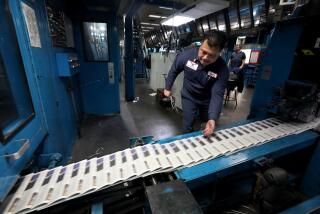Specialty media on the rise in Washington, study says
- Share via
Shifts in the way news is reported in Washington mean that average citizens find information about the government harder to come by, while an “elite” specialty audience has access to more information than ever, a study to be released today has found.
The Pew Research Center’s Project for Excellence in Journalism plans to report that -- while mainstream media outlets continue to diminish because of declining advertising -- specialty publications serving lobbyists and insiders are growing in size and influence.
“In short, those influencing policy have access to more information than ever, while those affected by those policies -- but not organized to shape them -- are likely to be less informed,” said the report, the result of a three-month review.
The “balance of information” has tilted away from average readers with the decline in general-interest news outlets. In 1985, reporters representing 564 outlets had credentials to cover Congress, while just 160 outlets had credentialed reporters as of 2007. The number has declined since then.
The decline has been felt across many media, notably regional newspapers, whose trade group had 200 member journalists in Washington in the mid-1990s and just 73 at the end of 2008. Newspaper reporters in Washington came from 35 states in 1985, compared to 23 today. A directory of news outlets showed that the three broadcast networks, meanwhile, have cut their total staffs by more than half over that same period.
Many venerable newspaper chains -- including Copley, Hearst, Newhouse and Cox -- have either closed or are expected to close their Washington bureaus this year. Tribune Co., owner of the Los Angeles Times, has reduced its staff by nearly two-thirds.
While general interest newspapers suffer, niche newspapers, newsletters and trade publications now number 437 in Washington, up from 310 in the mid-1980s. With names such as ClimateWire, Energy Trader and Food Chemical News, the publications go to specialized audiences willing to pay a premium to get inside information that can affect their businesses.
The study also found a dramatic increase in the foreign reporting staffs in Washington, from less than 200 correspondents in 1968 to more than 1,400 today.
--
More to Read
Sign up for Essential California
The most important California stories and recommendations in your inbox every morning.
You may occasionally receive promotional content from the Los Angeles Times.











